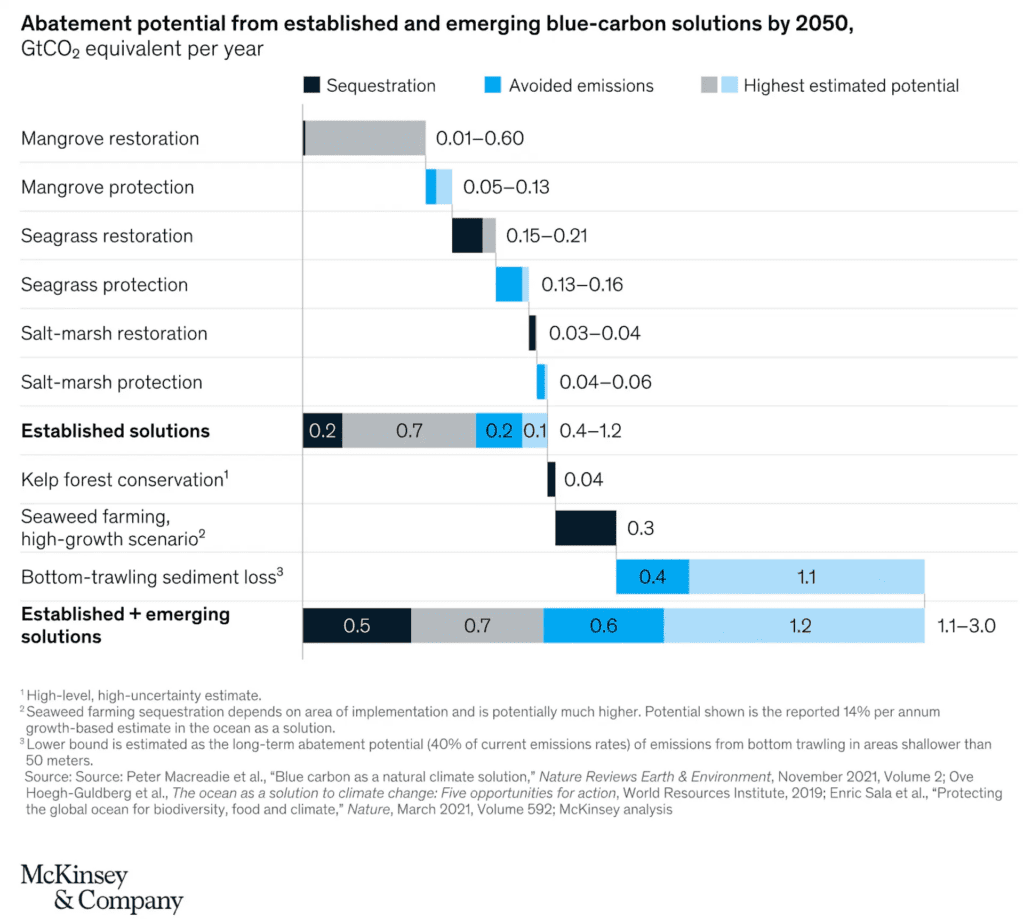In the last few years, a new method for carbon sequestration has captured the excitement of coastal and biodiversity enthusiasts in countries around the world. Referred to as ‘blue carbon’ projects, coastal and marine ecosystems such as mangrove forests, seagrass meadows, and salt marshes have massive potential to sequester carbon from the atmosphere and store it within their biomass and sediments.
As we mark International Day for the Conservation of the Mangrove Ecosystem on July 26, let’s unravel the magic of mangroves and other blue carbon projects and their invaluable contribution to our planet’s survival.
And carbon sequestration is just the beginning! Mangroves are not just climate warriors; they also deliver a plethora of other environmental boons. In this article, we’ll stroll through the world of blue carbon, probing into the critical role mangroves play in carbon sequestration and coastal resilience.
Plus, we’ll spotlight three outstanding projects making tangible strides in preserving and restoring coastal and marine ecosystems, helping us protect the wonders of blue carbon. So, let’s embark on this thrilling voyage as we delve into the power of mangroves, understand blue carbon, and learn how, together, we can safeguard our coastlines and mitigate climate change.
First Things First: What is ‘Blue Carbon’?
Blue carbon is one of nature’s ingenious strategies to stabilizing the carbon cycle. Called ‘blue carbon’ to distinguish from land-based carbon removal projects, these projects leverage the extraordinary ability of coastal ecosystems to capture and store CO2. These impressive habitats act as carbon guardians, absorbing CO2 from the air and safely locking it within their lush vegetation and underwater soils. Their role is paramount because they help reduce CO2 levels, aiding in our fight against climate change and stabilizing our planet’s temperature.
We most often think of mangrove forests when we talk about blue carbon, since there are more of these types of projects than seagrasses and salt marshes. But what is a mangrove forest? And what benefits does it provide?
Imagine a leisurely walk along a tropical coast, enveloped by a dense, verdant forest that sprouts from the water – that’s a mangrove forest!
Mangroves are rife with remarkable features:
- Carbon removal: Mangrove forests act like colossal sponges, absorbing carbon from the atmosphere and storing it in their leaves, branches, and trunks. And they’ve got another ace up their sleeve – they also bury carbon in their soils, making them the dual champions of carbon storage.
- Erosion protection: Among their coolest traits is their complex root network that spreads above and below the water, forming a natural bulwark against erosion and potent waves during storms. They serve as a protective shield for adjacent communities and provide a safe haven for marine life.
- Water purification: They also act as natural water purifiers, trapping sediments and pollutants, thus enhancing water quality.
- Biodiversity haven: Not to mention, they are bustling hubs of biodiversity, providing habitat for a myriad of species from fish and crabs to birds and monkeys.
- Economic benefit to coastal communities: Mangroves bring joy to local communities by providing bountiful fish, supporting livelihoods, and offering serene spots for nature enthusiasts to explore.
Three Pioneering Blue Carbon Projects
Blue carbon projects exist around the world, with many more locations where such projects could be implemented. Mangroves, seagrasses and tidal marshes cover around 193,051 square miles globally, across every continent except for Antarctica.
We’ll take a look at just a few projects:
- Vida Manglar, recognized by Verra, is the world’s first initiative to protect and account for the “blue carbon” in mangroves, both above and below water. Situated in Cispatá Bay along Colombia’s Caribbean coast, the project safeguards 11,000 hectares of mangrove forest and has issued 67,000 carbon credits. The project supports the livelihoods of 12,000 locals who use revenues from carbon credits for environmental stewardship. Over the next 30 years, Vida Manglar is projected to sequester 1 million metric tons of carbon dioxide, equivalent to removing 184,000 cars from the roads annually. Launched in 2015, Vida Manglar has sold all of its carbon credits, reinvesting the funds into the area’s conservation management plan, underlining the economic value of mangroves and ensuring their long-term protection with the active participation of local communities.
- BlueMX, a non-profit social entrepreneurship organization, is making waves in Mexico with their management of over 200,000 hectares of Mangrove Conservation and Restoration Projects. By collaborating with local communities, BlueMX meets the United Nations’ Sustainable Development Goals (SDGs) while also uplifting the social and economic well-being of local inhabitants.
- Mikoko Pamoja, a small-scale carbon offset project in Gazi Bay, Kenya, holds a grand vision to protect and restore mangroves while benefiting the community and environment. They generate revenue through the sale of carbon credits, which is reinvested into the community, supporting vital development projects in water and sanitation, education, health, and environmental conservation. This project is a resounding example of a ‘triple win’ for the climate, community, and biodiversity conservation.
High-Quality Blue Carbon Principles and Guidance
The “High-Quality Blue Carbon Principles and Guidance” were launched at the COP27 2022 United Nations Climate Change Conference. This first-of-its-kind framework was issued by a global coalition of ocean leaders and aims to ensure positive outcomes for the climate, nature, and people involved in blue carbon projects.
The key principles are:
- Safeguard Nature
- Empower People
- Employ the Best Information and Carbon Accounting Principles
- Operate Contextually and Locally
- Mobilize High Integrity Capital
The guide seeks to build confidence and momentum in blue carbon project development and investments by providing a shared vision of quality for all stakeholders.
As we celebrate Mangrove Day, let us honor the magic and might of mangroves and their blue carbon superpower. By protecting and restoring these precious habitats, we’re not just saving forests—we’re investing in our future, fostering biodiversity, improving livelihoods, and strengthening our fight against climate change. So, here’s to the remarkable world of mangroves and the endless possibilities they hold for a sustainable and resilient planet!
Interested in purchasing blue carbon credits? Get in touch with our sales team today!






